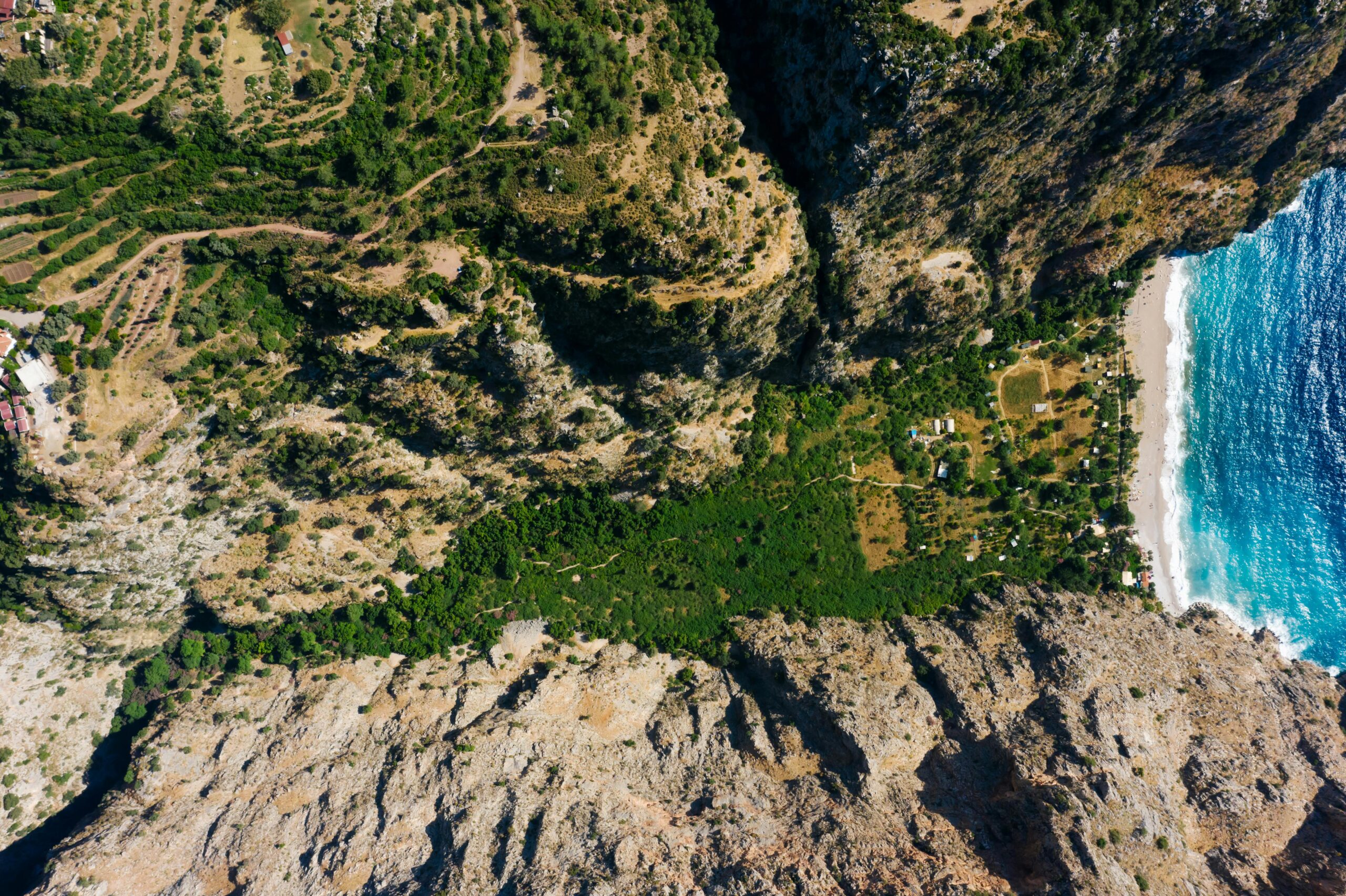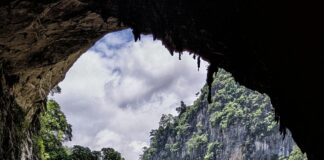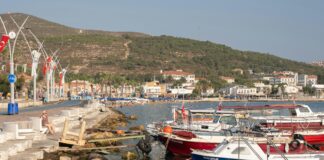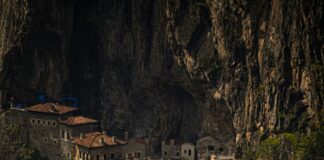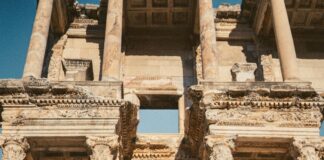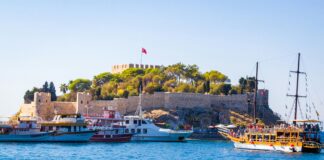Hiking The Lycian Way: Discover Turkey’s Most Scenic Route Adventure is an unforgettable journey that every outdoor enthusiast must experience at least once in their lifetime. This breathtaking hiking trail in Turkey offers a unique blend of rich history, stunning coastal views, and challenging terrains that will leave you craving for more. Have you ever wondered what it’s like to trek along one of the world’s most beautiful long-distance trails? Well, the Lycian Way is your answer, promising an epic adventure filled with ancient ruins, turquoise waters, and picturesque mountain landscapes that captivate the soul.
When it comes to hiking the Lycian Way, you’re not just walking a path—you’re immersing yourself in a story that dates back thousands of years. This scenic route in Turkey stretches over 540 kilometers along the southwestern coast, linking charming villages, hidden beaches, and rugged cliffs. Whether you’re a seasoned hiker or a casual traveler seeking an authentic experience, the Lycian Way offers something truly magical that will ignite your wanderlust and challenge your endurance. Want to uncover the secrets of Turkey’s stunning coastline while experiencing nature at its finest? This trail is your ultimate gateway to an outdoor adventure like no other.
So, pack your gear and get ready to explore the Lycian Way hiking trail—where every step reveals spectacular vistas and ancient treasures waiting to be discovered. Ready to embark on a journey that combines adventure travel, cultural exploration, and incredible natural beauty? Let’s dive into everything you need to know about hiking the Lycian Way, Turkey’s most scenic route that promises memories you’ll cherish forever.
Top 7 Must-See Highlights on the Lycian Way Hiking Trail in Turkey
Exploring the Lycian Way is like stepping into a storybook filled with ancient ruins, breathtaking coastlines, and charming villages. This trail, stretching over 500 kilometers along Turkey’s southwestern coast, offers an unforgettable hiking experience that attracts adventurers from all over the world. Hiking the Lycian Way is not just about walking; it’s about immersing yourself in nature, history, and culture. If you ever plan to discover Turkey’s most scenic route, knowing the top highlights along the way will help you make the most out of your trip.
What Makes the Lycian Way So Special?
Before diving into the must-see spots, it’s important to understand why this trail is so beloved. The Lycian Way was established in the 1990s by Kate Clow, a British expat who fell in love with the region’s natural beauty and ancient past. The path connects several ancient Lycian cities, secluded bays, and rugged mountain landscapes. Unlike many trails, the Lycian Way combines sea views with forested paths, meaning you can hike through pine forests one minute and be staring at the Mediterranean the next.
Top 7 Must-See Highlights on the Lycian Way
Here’s a list of the absolute must-see places you should not miss while hiking this trail. These spots offer a mix of nature, history, and local culture.
Olympos Ancient City and Beach
Olympos is an ancient Lycian city that dates back to the 2nd century BC. Walking through its ruins, you can see tombs, an ancient theater, and old city walls. Close to the ruins, there’s a beautiful beach where you can rest and swim. The surrounding forests are filled with wild strawberries and pine trees, making it perfect for a picnic.Chimaera (Yanartaş) Eternal Flames
One of the most unique natural wonders along the Lycian Way is the Chimaera flames. These burning fires emerge from vents in the rocks, fueled by natural gas escaping the earth. The flames have been burning for thousands of years, and ancient myths even linked them to the Chimera, a fire-breathing monster. Visiting at night feels magical, with the flickering flames against the dark sky.Patara Ancient City and Beach
Patara was once a prominent Lycian port city. Today, you can explore its well-preserved ruins, including a large theater, a parliament house, and a lighthouse. Nearby is Patara Beach, one of Turkey’s longest sandy beaches, known for its soft sand and sea turtle nesting sites. It’s a great spot to relax after a long day of hiking.Kabak Bay
Kabak Bay is a small, secluded cove that offers stunning turquoise waters and a peaceful atmosphere. It’s less developed than other spots on the trail, which means fewer tourists and more nature. Many hikers choose to stay overnight in eco-friendly bungalows or guesthouses here. The bay is also a starting point for hikes to nearby waterfalls and mountain peaks.The Lycian Rock Tombs at Dalyan
Dalyan is famous for both its natural beauty and ancient tombs carved into cliffs. These rock tombs date back to the 4th century BC and were made for Lycian kings. Dalyan also sits near the Iztuzu Beach, a protected area where loggerhead turtles lay their eggs. The combination of history and wildlife makes Dalyan a fascinating stop.Göynük Canyon
If you want some adventure beyond hiking, Göynük Canyon offers a chance for canyoning and swimming in natural pools. The canyon is surrounded by steep cliffs and lush vegetation. It’s a refreshing break from the trail, and you can even find small waterfalls during spring and early summer.Fethiye and Its Vibrant Marina
End your Lycian Way journey in Fethiye, a lively town with a beautiful marina, bazaars, and plenty of restaurants. Fethiye’s harbor is filled with traditional wooden boats called gulets, which you can rent for day trips to nearby islands. The town also serves as a gateway to the famous Butterfly Valley and Ölüdeniz Beach.
Practical Tips for Hiking the Lycian Way
- Best Time to Go: Spring (April to June) and fall (September to November) are the best seasons. Summers can get very hot, making hiking difficult.
- What to Pack: Comfortable hiking boots, water bottles, sunscreen, and a hat. Don’t forget a camera because the views are spectacular.
- Accommodation Options: Along the trail, there are various guesthouses, eco-lodges, and small hotels. Some villages offer homestays where you can experience local life.
- Navigation: The path is marked with red and white stripes
How to Prepare for a Multi-Day Trek on the Lycian Way: Essential Tips
The Lycian Way is one of Turkey’s most famous hiking trails, stretching over 500 kilometers along the stunning Mediterranean coast. If you ever dreamed about walking through ancient ruins, pine forests, and turquoise sea views, this trail is perfect for you. But before you just pack your bag and start walking, there are many things to consider. How to prepare for a multi-day trek on the Lycian Way? What you need to know about hiking this scenic route? This article will guide you through some essential tips, so you can enjoy the adventure without any unexpected surprises.
Why the Lycian Way is Special
This trail is not just another hiking path. It is a journey back in time to the land of the Lycians, an ancient civilization that lived in this region over 2500 years ago. Along the way, you will find ruins of ancient cities like Patara, Olympos, and Xanthos, which are UNESCO World Heritage sites. The trail also passes through traditional Turkish villages where you can experience local culture and hospitality. Plus, the views are breathtaking—imagine walking along cliffs overlooking the Mediterranean Sea, with wildflowers and pine trees around you.
Essential Gear for the Lycian Way Trek
You must pack carefully if you want to survive and enjoy the trek. The weather in this region can be very hot in summer and quite wet in spring or autumn. Here is a list of essentials for a multi-day trek:
- Backpack: Choose one with good support and enough capacity for 40-50 liters.
- Footwear: Hiking boots or sturdy trail shoes that you already break-in to avoid blisters.
- Clothing: Lightweight, moisture-wicking clothes, a hat, sunglasses, and a rain jacket.
- Sleeping Gear: A lightweight sleeping bag and a sleeping pad if you plan to camp.
- Navigation: A map of the Lycian Way, a compass, or a GPS device.
- Water Supply: At least 2 liters per day, with the possibility to refill in villages or springs.
- Food: High-energy snacks like nuts, dried fruits, and energy bars.
- First Aid Kit: Including blister treatment, painkillers, and any personal medication.
- Sun Protection: Sunscreen and lip balm with SPF.
Planning Your Route and Accommodation
The Lycian Way is divided into many stages, usually covered in 20-30 days if you want to walk the entire trail. But you can also choose shorter sections, depending on your time and fitness level. Planning your route is important because some parts are more remote, and accommodations can be scarce.
Here is an example outline of a popular 7-day itinerary:
| Day | Route | Distance (km) | Accommodation |
|---|---|---|---|
| 1 | Fethiye to Faralya | 20 | Guesthouse in Faralya |
| 2 | Faralya to Kabak | 15 | Camping or bungalow in Kabak |
| 3 | Kabak to Alınca | 18 | Pension in Alınca |
| 4 | Alınca to Ölüdeniz | 22 | Hotel in Ölüdeniz |
| 5 | Ölüdeniz to Faralya | 19 | Guesthouse in Faralya |
| 6 | Faralya to Butterfly Valley | 12 | Camping in Butterfly Valley |
| 7 | Butterfly Valley to Fethiye | 14 | Return to Fethiye |
Accommodation options along the trail include small pensions, guesthouses, and campsites. Booking ahead during peak season (May to October) recommended, because places fill quickly.
Physical Preparation and Training Tips
Walking on the Lycian Way is not easy. The trail has steep climbs and descents, rough terrain, and sometimes slippery rocks. To prepare your body:
- Start regular walking or hiking a few months before your trip.
- Include uphill walking and stair climbing to build leg strength.
- Practice carrying your loaded backpack to get used to the weight.
- Stretch daily, especially focusing on calves, hamstrings, and lower back.
- Build endurance by doing longer walks on weekends.
If you have any health conditions or injuries, consult a doctor before starting your trek.
What Makes the Lycian Way Different from Other Trails?
Compared to other famous routes like the Camino de Santiago in Spain or the Appalachian Trail in the US, the Lycian Way offers a unique blend of ancient history and natural beauty. While other trails are often crowded and commercialized, the Lycian Way remains less touristy and more authentic. The climate is Mediterranean, which means hot dry summers and mild winters, unlike the colder mountain trails in Europe. Also, the trail’s proximity to the sea means you can swim in the Mediterranean after a long day’s walk—something hard to find elsewhere.
Practical Advice for Daily Hiking on the Lycian Way
- Start early in the morning to avoid the midday heat.
- Take regular breaks and drink plenty of water.
Discover Hidden Ancient Ruins Along the Scenic Lycian Way Route
Discover Hidden Ancient Ruins Along the Scenic Lycian Way Route
If you are someone who loves hiking, history, and nature all rolled into one adventure, then you must consider exploring the Lycian Way in Turkey. This trail is famous for its breathtaking views over the Mediterranean Sea and its fascinating ancient ruins hidden along the path. The Lycian Way is not just a hike; it is a journey back in time where you can witness the stories of civilizations that lived thousands years ago. The trail stretches over 540 kilometers and runs through the southwestern coast of Turkey, offering hikers a chance to immerse themselves in a blend of scenic landscapes and cultural heritage.
What Makes the Lycian Way Special?
The Lycian Way is Turkey’s most scenic route adventure, and it got its name from the ancient Lycian civilization which flourished in this region. The trail passes through mountain ridges, olive groves, pine forests, and stunning coastal cliffs. Unlike many other hiking trails, the Lycian Way combines natural beauty with historical significance. Along the way, you will find many ruins of Lycian cities, Roman artifacts, and Byzantine churches which tells stories of various empires that ruled this land.
Some features that makes the Lycian Way unique include:
- Over 80% of the trail runs along the coast, providing spectacular sea views.
- Numerous hidden ruins and archaeological sites are scattered along the route.
- The path is marked clearly, but some sections require good hiking experience.
- Local villages offer traditional Turkish hospitality and local cuisine.
- The trail can be divided into smaller sections for day hikes or multi-day treks.
Ancient Ruins You Can Discover on the Trail
One of the major attractions of hiking the Lycian Way is the chance to explore ancient ruins that are often overlooked by regular tourists. These ruins are not fenced or turned into big tourist sites, meaning you can experience them almost like an explorer discovering a lost city.
Here are some must-visit ruins along the Lycian Way:
- Patara: Once the capital of Lycia, Patara has a large ancient theater, ruins of a parliament building, and a beautiful sandy beach nearby.
- Xanthos: A UNESCO World Heritage site, Xanthos was a major city in Lycian times. It features impressive tombs carved into cliffs and ancient temples.
- Olympos: A city that was destroyed by fire in the 4th century, today it is surrounded by lush forests and offers a glimpse into Lycian urban life.
- Phaselis: Known for its three harbors, Phaselis is a coastal city with Roman baths, aqueducts, and ancient streets.
- Kekova: Famous for its sunken city ruins, Kekova is best seen by boat, but nearby trails provide stunning views of the submerged structures.
Hiking the Lycian Way: What to Expect
Hiking the Lycian Way is not a walk in the park, and it require some preparation. The terrain varies from rocky mountain paths to sandy beaches, and the weather can be quite hot in summer. You should pack comfortable hiking shoes, plenty of water, and sun protection. Many hikers choose to do the trail in spring or autumn when the temperatures are milder.
The trail is usually divided into 29 sections, and each section has its own character. For example:
- The first sections near Fethiye offers forested paths and panoramic views.
- Midway through, near Demre and Finike, you will pass through ancient ruins and citrus orchards.
- The southern sections near Antalya have more coastal views and warm beaches.
If you want to hike the entire trail, it can take about 3 weeks, but many hikers prefer to do parts of it over several trips. Villages along the route provide accommodation options, from simple guesthouses to cozy boutique hotels.
Villas and Accommodation Along the Lycian Way
While the trail is popular among backpackers, there are also luxurious villas and holiday homes available for those who seek comfort after a long day of hiking. Renting a villa near the Lycian Way can give you a peaceful retreat with stunning views, privacy, and local charm.
Benefits of staying in villas include:
- More space and privacy compared to hotels.
- Access to kitchens for preparing your own meals.
- Often located in scenic spots close to nature and historic sites.
- Perfect for groups or families wanting to explore the area at their own pace.
Some popular towns and villages where you can find villas are:
- Oludeniz: Famous for its blue lagoon and paragliding, Oludeniz has many villas with sea views.
- Kalkan: A charming town with white-washed houses, local markets, and upscale villas.
- Kas: Known for its bohemian vibe, Kas offers villas close to the trail and ancient ruins.
- Demre: Near the ruins of Myra and St. Nicholas Church,
Best Time of Year to Hike the Lycian Way for Stunning Coastal Views
Exploring Turkey’s breathtaking landscapes is a dream for many travelers, and one of the best ways to experience this country is by hiking the Lycian Way. This famous trail offers some of the most stunning coastal views you ever seen, winding through ancient ruins, pine forests, and turquoise bays. But when is the best time of year to hike the Lycian Way? And what makes this route so special compared to others? Let’s dive into these questions and discover why this scenic route is a must-do adventure for those visiting Turkey.
Why Hiking the Lycian Way is a Unique Experience
The Lycian Way stretches about 540 kilometers (335 miles) from Fethiye to Antalya along Turkey’s Mediterranean coast. This trail is not just a path, it’s a journey back in time. The route passes by remnants of the Lycian civilization, including rock tombs, amphitheaters, and ancient cities like Olympos and Phaselis. Hikers get to walk through diverse landscapes — from rugged cliffs and olive groves to sandy beaches and mountain plateaus.
What makes the Lycian Way stand out is its combination of natural beauty and historical richness. While you hike, you see the bright blue sea on one side and the Taurus Mountains on the other. It’s like walking through a living museum where every step tells a story.
Best Time of Year to Hike the Lycian Way for Stunning Views
Picking the right season to hike the Lycian Way is important because the weather can greatly affect your experience. The trail is open year-round, but some months are better than others.
- Spring (March to May): This is probably the best time to hike. The temperatures are mild, usually between 15°C and 25°C (59°F to 77°F), perfect for long walks. The wildflowers bloom along the path, adding bursts of color to the already gorgeous scenery. Also, spring rains make the landscape lush and green.
- Autumn (September to November): Another great season to explore the trail. The heat of summer has faded, and the sea remains warm enough if you want to swim. The weather is comfortable for hiking, but you might encounter some rainy days later in November.
- Summer (June to August): Summer can be very hot, especially in July and August, with temperatures soaring over 35°C (95°F). Hiking during midday hours is not recommended due to the risk of heat exhaustion. If you still want to go in summer, plan hikes early morning or late afternoon and carry plenty of water.
- Winter (December to February): Winters are mild compared to many places, but some parts of the trail, especially in higher altitudes, can be cold and rainy. Snow is rare but possible in mountain areas. This season is less popular for hiking, but also less crowded.
What to Expect on the Lycian Way – Highlights and Challenges
The Lycian Way is famous for its variety. You will pass:
- Coastal cliffs with panoramic views of the Mediterranean Sea.
- Ancient ruins such as the sunken city of Kekova and the Lycian rock tombs carved into cliffs.
- Forests and mountain trails that offer peaceful respite from the seaside.
- Traditional Turkish villages where locals welcome hikers with warm hospitality.
The trail is marked well, but some parts can be steep or rocky, so hiking boots are necessary. The route is divided into sections — some easy for beginners, others more challenging for experienced hikers. It’s important to plan your daily distances depending on your fitness level.
Comparing the Lycian Way to Other Hiking Routes in Turkey
Turkey has many hiking trails, but the Lycian Way is often considered the most scenic. Here’s a quick comparison:
| Trail Name | Length (km) | Landscape Type | Historical Sites | Difficulty Level | Best Time to Visit |
|---|---|---|---|---|---|
| Lycian Way | 540 | Coastal cliffs, forests | Lycian ruins, ancient cities | Moderate to challenging | Spring, Autumn |
| St. Paul Trail | 500 | Mountains, valleys | Early Christian sites | Moderate | Spring, Autumn |
| Kaçkar Trail | 120 | Alpine, mountain lakes | Minimal | Challenging | Summer |
While the St. Paul Trail focuses more on Christian heritage and inland mountain scenery, the Lycian Way offers a perfect mix of coastline and history. The Kaçkar Trail is best for adventure lovers seeking alpine challenges but lacks coastal views.
Practical Tips for Hiking the Lycian Way
- Start early in the day to avoid midday heat, especially in summer.
- Carry enough water and snacks, since some parts have limited services.
- Plan accommodations ahead; villages along the trail
What to Pack for Your Ultimate Lycian Way Hiking Adventure in Turkey
The Lycian Way is one of the most breathtaking hiking trails in Turkey, attracting adventurers from all around the world. Stretching roughly 540 kilometers along the southwestern coast of Turkey, this route offers stunning views of the Mediterranean Sea, ancient ruins, and charming villages. If you are planning to hike this legendary trail, knowing what to pack for your ultimate Lycian Way hiking adventure is super important. The right gear can make your journey much more enjoyable and safe, while the wrong stuff might drag you down or cause problems on the path.
Why Hiking the Lycian Way is a Unique Experience
Before we dive into what to pack, it’s good to understand why the Lycian Way stands out. This trail was established in the 1990s by a British tour guide, Kate Clow, who wanted to preserve and showcase the cultural heritage of the Lycian civilization. You will walk through diverse landscapes including pine forests, rocky cliffs, sandy beaches, and historic ruins dating back thousands of years. Unlike many other hiking routes, the Lycian Way is well-marked but still remote enough to give you a true sense of adventure and discovery.
Essential Clothing Items You Should Take
Packing smart clothes for your hike is essential because the weather can vary greatly. The summers in this region are hot and dry, but evenings and early mornings may be cool, especially in the mountainous parts.
- Lightweight, breathable hiking shirts (preferably those dry fast)
- A good pair of sturdy hiking boots with ankle support
- Comfortable hiking socks (bring extra pairs)
- A wide-brimmed hat or cap to protect from sun
- A lightweight rain jacket or poncho (weather can be unpredictable)
- Quick-dry hiking pants (convertible pants that turn into shorts are useful)
- Layered clothing options for cool mornings or evenings (a fleece or light pullover)
- Swimsuit (you might want to swim in hidden coves or beaches)
Important Hiking Gear to Bring Along
Besides clothes, there are several must-have hiking gear items you cannot forget. Carrying too much weight will tire you, but going underprepared can be risky.
| Item | Why It’s Important |
|---|---|
| Backpack (30-40L) | Holds all your gear without being too heavy |
| Hydration system or water bottles | Staying hydrated is critical on this trail |
| Map and compass or GPS device | Navigation help when you lose track of markers |
| First-aid kit | Injuries or insect bites are possible |
| Multi-tool or knife | Handy for many small tasks |
| Sunblock and lip balm with SPF | Protect your skin from strong sun rays |
| Headlamp or flashlight | Useful for early starts or late arrivals |
| Trekking poles | Reduces strain on knees, especially downhill |
| Sleeping bag or liner | If you plan to camp or stay in basic shelters |
| Portable charger or power bank | Keeps your phone or GPS charged |
Food and Water Considerations on the Trail
One of the biggest challenges on the Lycian Way is managing your food and water. Villages and small towns along the route offer places to rest and resupply, but some stretches are long and isolated.
- Pack lightweight, high-energy snacks like nuts, dried fruit, energy bars, and jerky
- Instant soups or noodles can be quick meals if you carry a portable stove
- Carry enough water for at least a day’s walk; water sources may be scarce, especially during summer
- A water purification method (tablets, filters) is recommended because natural water may not be safe
Accommodation Choices: From Villages to Villas
While the Lycian Way is primarily a hiking trail, your overnight stays can vary widely. Many hikers choose to stay in pensions, guesthouses, or small hotels in the villages along the path. However, if you prefer more comfort or want to recover in style after a long day, there are beautiful villas and holiday homes available nearby.
Some villas offer:
- Private pools to relax your muscles
- Stunning sea views and peaceful surroundings
- Fully equipped kitchens to prepare your own meals
- Easy access to trailheads and local attractions
Booking a villa near the trail can be a great way to combine adventure with relaxation, especially if you are traveling with family or a group.
Comparing the Lycian Way with Other Famous Hiking Trails
If you think about other famous long-distance hikes like the Camino de Santiago in Spain or the Appalachian Trail in the US, the Lycian Way has some unique features:
- Mediterranean climate means mostly dry and warm weather, unlike the often rainy or cold conditions in other trails
- Rich ancient history with ruins from Lycians, Romans, and Byzantines along the way
- Coastal views that are hard to beat, with plenty of opportunities to swim in the sea
- Less crowded, giving you a more solitary and peaceful hiking experience
Practical Tips for Your Lycian Way Packing
Exploring Lycian Way Villages: Authentic Turkish Culture and Hospitality
Exploring the Lycian Way Villages: Authentic Turkish Culture and Hospitality Awaits
If you ever dream about walking a path where history, nature, and traditional Turkish life meets, the Lycian Way is a must-see. This hiking trail, stretching over 500 kilometers along the southwestern coast of Turkey, offers more than just stunning views. The villages dotting this route give travelers a chance to dive into authentic Turkish culture and hospitality that is rarely found in big cities or tourist resorts. Each village has its own story, charm, and a warm welcome that makes the journey unforgettable.
What is the Lycian Way?
The Lycian Way is one of the most famous long-distance hiking trails in Turkey, and even in the world. It runs from Fethiye to Antalya, passing through ancient Lycian cities, beautiful pine forests, and crystal-clear Mediterranean coves. The trail was first created in the 1990s by Kate Clow, a British traveler who fell in love with the area. Since then, it has become a favorite for adventurers, history lovers, and nature enthusiasts.
The route is not just about walking; it is like stepping back in time. The Lycians were an ancient civilization dating back to 15th century BC, known for their unique rock tombs and democratic city-states. Along the way, you can find ruins that tell stories of past empires like Romans and Byzantines, blending history and natural beauty in one experience.
Villages Along the Lycian Way – What Makes Them Special?
The villages along the Lycian Way are small, often hidden from modern hustle and bustle. Life there moves slow and simple. These villages are where you can truly experience real Turkish hospitality. Visitors often find themselves invited for tea, home-cooked meals, or just a friendly chat with locals who love sharing their culture.
Here are some notable villages you should not miss:
- Faralya: Known for its breathtaking views over Butterfly Valley, Faralya is a quiet village where traditional wooden houses line the narrow streets. The villagers are mostly farmers and fishermen, offering fresh local produce and seafood.
- Kayaköy: An abandoned Greek village turned open-air museum, Kayaköy shows the history of population exchanges in early 20th century Turkey. Walking through its empty stone houses gives a haunting yet fascinating glimpse into the past.
- Ölüdeniz: Famous for its blue lagoon and paragliding, Ölüdeniz also has a small village charm away from the beach crowds, where you can find handmade crafts and local delicacies.
- Gavurağılı: A tiny mountain village, Gavurağılı is perfect for travelers looking to experience mountain life and traditional Turkish village hospitality. People there often invite hikers to join in on their daily routines.
Hiking the Lycian Way: What to Expect from the Adventure
Trekking the Lycian Way is both rewarding and challenging. The path varies from easy coastal walks to steep mountain trails. It is important to prepare well, but the effort always pays off with views and experiences that are hard to find elsewhere.
Some things you should know before starting:
- The trail is marked with red and white stripes, but sometimes signs are missing or confusing, so carrying a map or GPS device is recommended.
- Weather can be unpredictable. Summers are hot and dry, while spring and autumn offer cooler temperatures but occasional rain.
- Accommodation options range from camping to staying in guesthouses or small hotels in villages.
- Local food is a highlight. Expect fresh olives, cheese, bread, and seasonal fruits served in simple but delicious ways.
- Wildlife like wild goats, birds, and even sea turtles can be spotted along the way.
Comparison: Lycian Way Villages vs. Tourist Resorts
Many tourists visit Turkey for its popular coastal resorts like Antalya or Bodrum. While these places offer luxury and convenience, the Lycian Way villages provide a completely different experience:
- Authenticity: Villages keep traditional ways of life alive, unlike resorts that focus on mass tourism.
- Nature: The trail offers untouched landscapes with less pollution and noise.
- Cultural Interaction: Visitors have real chances to meet locals and learn about their customs.
- Pace: Life in villages is slower, giving travelers a chance to relax and immerse themselves in surroundings.
- Cost: Staying in villages is often more affordable than in crowded resort towns.
Practical Tips for Visiting Lycian Way Villages
To make your trip enjoyable and respectful, consider these points:
- Learn a few basic Turkish phrases. Simple greetings or thank yous go a long way.
- Carry cash, as many small shops and cafes do not accept cards.
- Dress modestly when visiting villages, especially in conservative areas.
- Respect local customs and privacy. Ask before taking photos of people or their homes.
- Support local businesses by buying handmade souvenirs or eating at village
Lycian Way Difficulty Levels: Who Should Attempt This Scenic Hiking Route?
Exploring the Lycian Way is like stepping into a living postcard of Turkey’s southern coast. This trail, stretching over 500 kilometers from Fethiye to Antalya, offers breathtaking views of the turquoise Mediterranean Sea, ancient ruins, and rugged mountain landscapes. But before you pack your hiking boots and jump into this adventure, it’s important to know about the Lycian Way difficulty levels and who should really attempt this scenic hiking route. It’s not for everyone, and understanding the challenges will help you enjoy the journey more.
What Is the Lycian Way?
The Lycian Way is one of Turkey’s most famous long-distance hiking trails. It follows the coastline of ancient Lycia, a region known for its unique culture and history dating back to 5th century BC. Along the way, hikers can discover ruins of Lycian cities, Roman baths, Byzantine churches, and Ottoman bridges. The mix of natural beauty and archaeological heritage makes it a favorite for travelers who want more than just a beach vacation.
This trail was established in the 1990s by a British expat named Kate Clow, who helped map it and promote it internationally. Since then, it attracts hikers from all around the world. The route is usually divided in stages, so people can choose to hike short sections or the entire path within a few weeks.
Lycian Way Difficulty Levels: What To Expect?
The trail difficulty varies a lot depending on which section you choose. Some parts are relatively easy with well-marked paths and gentle slopes, while others are tough with steep climbs and rocky terrain. Here’s a general breakdown of the difficulty levels you might encounter:
- Easy Sections: These are mostly coastal stretches with gradual inclines, good for beginners or casual walkers. Examples include the path between Ölüdeniz and Kabak Beach.
- Moderate Sections: These involve longer distances with some uphill and downhill, requiring good fitness and stamina. The section between Kabak and Faralya is a good example.
- Hard Sections: Steep climbs, rocky surfaces, and sometimes unmarked paths make these areas challenging. The segment near Geyikbayırı involves tough mountain hiking.
Some hikers underestimate the trail thinking it’s an easy stroll, but the Lycian Way demands preparation. Weather can be hot in summer, and water sources are limited on some stretches, adding to the difficulty.
Who Should Attempt The Lycian Way?
Not everyone should jump on the Lycian Way without thinking. This route is best for people who:
- Have previous hiking experience, especially on uneven or mountainous terrain.
- Are physically fit and able to walk several hours daily.
- Can navigate using maps or GPS, since some parts have poor signage.
- Enjoy history and nature, because the trail is rich in both.
- Are prepared for changing weather and carrying their own supplies.
Families with small children or elderly travelers might find the trail too demanding unless they stick to the easier sections. Also, solo hikers should be cautious and inform someone about their plans due to isolated areas.
Comparing Lycian Way With Other Famous Trails
How does the Lycian Way stack up against other popular hiking routes? Here is a quick comparison:
| Trail Name | Location | Distance (km) | Difficulty | Highlights |
|---|---|---|---|---|
| Lycian Way | Turkey | 540 | Easy to Hard | Ancient ruins, Mediterranean views |
| Camino de Santiago | Spain | 780 | Moderate | Historical cathedrals, cultural towns |
| Appalachian Trail | USA | 3500 | Hard | Dense forests, wildlife sightings |
| Tour du Mont Blanc | France/Italy/Switz | 170 | Moderate to Hard | Alpine scenery, glaciers |
The Lycian Way is unique because it combines coastal hiking with historic sites in a Mediterranean climate. It’s shorter than the Appalachian Trail but has more varied terrain than the Camino de Santiago.
Practical Tips For Hiking the Lycian Way
To get the most out of your hike, consider these tips:
- Choose Your Season Wisely: Spring (April to June) and autumn (September to November) offer the best weather. Summers can be scorching.
- Pack Light But Smart: Bring sturdy hiking shoes, sun protection, enough water, and snacks. Some parts have no shops nearby.
- Stay In Villages or Villas: The route passes small villages where you can find guesthouses or traditional villas to rest. Staying in these accommodations gives a more authentic experience.
- Use Local Guides If Needed: If you not confident about navigation or want more info about the history, local guides are available.
- Plan Your Daily Distances: Depending on your fitness, plan between 10 to 20 kilometers per day.
- Respect Nature and Culture: The trail crosses private lands and archaeological sites. Always follow rules and leave no trace.
Where to Find the Most Breathtaking Photo Spots on the Lycian Way Trail
When you think about hiking in Turkey, the Lycian Way trail often comes to mind. It is not just a path but a journey through history, nature, and some of the most stunning landscapes anyone could ever see. This trail stretches over 500 kilometers along the southwestern coast of Turkey, offering breathtaking views of the Mediterranean Sea, ancient ruins, and charming villages. But where to find the most breathtaking photo spots on the Lycian Way trail? And how can you make your adventure more memorable by staying in unique villas along the way? Let’s explore the beauty and secrets of this incredible route.
Why Hiking the Lycian Way is a Must-Do Adventure
The Lycian Way is famous for its scenic diversity. You walk through pine forests, rocky cliffs, and turquoise bays. It’s a trail that connects ancient Lycian cities with traditional Turkish villages. The trail starts from Fethiye and ends in Antalya, making it a long but rewarding hike. Along the way, you will encounter ruins that date back thousands of years, like the ancient city of Patara with its enormous beach or the rock tombs carved into cliffs at Dalyan.
Some key features that make the Lycian Way special:
- Mix of nature and history in every step.
- Panoramic views of the Mediterranean coast.
- Opportunity to meet locals in small villages.
- Variety of terrains, from easy paths to challenging climbs.
Because of these reasons, many hikers say the Lycian Way is Turkey’s most scenic route.
Top Photo Spots Along the Lycian Way Trail
If your trip is about capturing incredible moments, here are some spots where your camera will love to work overtime.
Ölüdeniz Blue Lagoon
Famous worldwide, Ölüdeniz offers a stunning turquoise lagoon surrounded by mountains. The aerial views from the Babadağ mountain are particularly spectacular. Paragliders often fill the sky, adding dynamic elements to photos.Butterfly Valley (Kelebekler Vadisi)
Accessible by boat or a steep hike, this valley is a hidden paradise. It’s filled with butterflies during summer months, dramatic cliffs, and a secluded beach. The contrast between the green valley and the deep blue sea is perfect for nature photography.Ancient City of Xanthos
This UNESCO World Heritage site has well-preserved ruins and tombs. The stone monuments provide a dramatic foreground for sunset or sunrise shots, with the mountains in the background.Patara Beach and Ruins
Patara’s long sandy beach is one of the most beautiful in Turkey. The nearby ruins of the ancient city, including a Roman theater and a lighthouse, add historical depth to your photos.Geyikbayırı Cliffs
Not far from Antalya, these cliffs are famous for rock climbing but also offer amazing sunset views. The rough textures of the limestone and the vast sky create a dramatic scene.
Where to Stay: Unique Villas Along the Lycian Way
While camping is popular on the trail, many hikers prefer resting in comfortable villas that offer both local charm and modern amenities. Staying in a villa gives you the chance to relax after a day of trekking, enjoy local cuisine, and soak in authentic Turkish hospitality.
Here’s a list of recommended villas:
- Villa Lykia, Ölüdeniz: A luxury villa complex with private pools and stunning sea views. Ideal for families or groups wanting comfort after hiking.
- Kalkan Hillside Villas: Located in the picturesque town of Kalkan, these villas combine traditional architecture with modern design. Perfect for exploring nearby Lycian ruins.
- Kas Villa Retreat: Kas is a small coastal town famous for its laid-back vibe. Here, you can find charming stone villas with terraces overlooking the sea.
- Patara Villa Gardens: Near the ancient city of Patara, these villas offer easy access to the beach and ruins, surrounded by olive groves.
- Fethiye Old Town Villas: Staying here means you’re close to the trail start and the lively bazaar. Some villas have rooftop terraces for panoramic views of the harbor.
Practical Tips for Hiking the Lycian Way
Before you start your adventure, keep in mind these important points:
- The best seasons to hike are spring (April to June) and autumn (September to November) to avoid the extreme summer heat.
- Pack lightweight gear but bring sturdy hiking boots because some parts of the trail are rocky.
- GPS devices or detailed maps are essential; the trail markings sometimes vanishes in remote areas.
- Local villages along the trail provide food and water, but it is smart to carry enough supplies for longer stretches.
- Respect nature and historical sites. Don’t leave trash and avoid damaging ruins.
Comparing Lycian Way to Other Trails in Turkey
Turkey offers many beautiful trails, but Lycian Way stands out for its coastal views and ancient heritage. For example:
| Trail Name
Combining Lycian Way Hiking with Turkish Cuisine: A Food Lover’s Guide
The Lycian Way is one of Turkey’s most stunning hiking trails, stretching over 500 kilometers along the Mediterranean coast. It is famous not only for its breathtaking views but also for the chance to explore ancient ruins, charming villages, and rich culture. But what makes this adventure even better is combining it with Turkish cuisine. Imagine hiking through rugged landscapes during the day and enjoying delicious local food in the evening! For food lovers and adventure seekers alike, this combination creates an unforgettable travel experience you do not want to miss.
Why The Lycian Way Is So Special
The Lycian Way was established in the 1990s and follows the ancient Lycian civilization’s routes. Lycian civilization dates back over 2,500 years, famous for its unique rock tombs and maritime culture. The trail starts near Fethiye and ends in Antalya, covering a diverse range of landscapes including turquoise bays, pine forests, and mountain paths. Along the way, hikers will pass through small villages where time seems to stand still, and the local way of life is still very much alive.
Some key highlights that make the Lycian Way a must-visit:
- Ancient cities like Olympos, Phaselis, and Patara
- Spectacular views of the Mediterranean Sea
- Olive groves, citrus orchards, and wildflowers
- Friendly locals who welcome hikers with hospitality
- Opportunities to try authentic Turkish dishes made from fresh ingredients
Turkish Cuisine: A Perfect Match for Hikers
Turkish cuisine is rich, diverse, and uses fresh produce that perfectly suits a hiker’s nutritional needs. The food is full of flavors, herbs, and spices which makes every meal a delight. While hiking the Lycian Way, you can enjoy meals that are both energizing and comforting after a long day on the trail.
Here are some typical Turkish dishes you might encounter along the route:
- Gözleme: Thin pastry filled with spinach, cheese, or meat, cooked on a griddle.
- Menemen: A scrambled eggs dish with tomatoes, peppers, and onions.
- Kebabs: Various grilled meats served with rice and salad.
- Meze: Small appetizers like hummus, baba ghanoush, and stuffed grape leaves.
- Baklava: Sweet pastry layered with nuts and honey to finish your meal.
Many of the villages along the Lycian Way have family-run restaurants or small markets where you can try these dishes made from local recipes passed down generations.
Staying in Villas Along The Lycian Way
While camping and guesthouses are popular among hikers, staying in villas can add a touch of comfort and luxury to your adventure. Villas often provide a peaceful retreat to relax, enjoy home-cooked meals, and recharge before another day of hiking. Some villas even offer cooking classes where you can learn how to make Turkish dishes yourself!
Here’s what you can expect from villas near the Lycian Way:
- Private gardens with olive trees and herbs
- Stunning sea or mountain views
- Access to outdoor kitchens or barbecue areas
- Comfortable rooms with authentic Turkish decor
- Proximity to hiking trailheads and local markets
If you like, you can also combine a villa stay with guided hiking tours that include stops for tasting local delicacies or visits to small farms and vineyards.
Practical Tips for Combining Hiking and Food Exploration
Hiking the Lycian Way while enjoying Turkish cuisine requires some planning, especially if you want to make the most of both. Here are a few tips that can help:
- Pack smart: Bring lightweight cooking gear if you plan to cook at your villa or campsite.
- Try local markets: Visit village markets for fresh fruits, vegetables, olives, and cheese.
- Ask locals: They often know the best dishes and where to find authentic food.
- Stay hydrated: Carry enough water, especially when hiking in summer heat.
- Book accommodations early: Villas and guesthouses can fill up during peak season.
- Learn some Turkish phrases: Words like “lezzetli” (delicious) and “teşekkür ederim” (thank you) go a long way.
Comparing Hiking Options: Lycian Way vs Other Trails in Turkey
Turkey offers many hiking trails, but the Lycian Way stands out for its combination of history, scenery, and food experiences. Let’s compare it briefly with other popular routes:
| Trail Name | Length (km) | Main Features | Food Experience |
|---|---|---|---|
| Lycian Way | 540 | Coastal views, ancient ruins | Rich local cuisine, village meals |
| Kaçkar Mountains | 170 | Alpine scenery, high elevations | More rustic, less variety in food |
| St. Paul Trail | 500 | Historical sites, mixed landscapes | Mediterranean dishes, fewer |
How to Navigate the Lycian Way: Maps, Apps, and Local Guide Recommendations
Exploring the Lycian Way is one of the best adventures you can have in Turkey. This trail, stretching over 500 kilometers along the southwestern coast, offers some of the most stunning landscapes, ancient ruins, and charming villages. But hiking the Lycian Way is not just about walking; it requires some navigation skills, tools, and local know-how to truly enjoy the journey. If you ever wonder how to navigate the Lycian Way, what maps or apps to use, or if you need a local guide, this article will give you a handy overview.
What is the Lycian Way and Why It’s So Popular?
The Lycian Way is a long-distance footpath that runs from Fethiye to Antalya, passing through a region that was once home to the ancient Lycian civilization. The trail follows rugged coastlines, pine forests, and olive groves, while giving hikers a glimpse of historical sites like the ruins of Patara, Xanthos, and Olympos. The route was established in the 1990s by Kate Clow, a British expat, and has since become Turkey’s most scenic hiking trail.
- Length: Approximately 540 kilometers (335 miles)
- Duration: Usually takes 3–4 weeks to complete fully
- Terrain: Rocky paths, steep climbs, coastal views, and forest tracks
- Difficulty: Moderate to challenging
Many people come from all around the world to experience the Lycian Way hiking because it combines natural beauty with history, culture, and local hospitality.
Maps and Printed Guides for the Lycian Way
Before starting your trek, having a reliable map is crucial because the trail markers sometimes are faded or missing. There are several printed maps and guidebooks available:
- The Lycian Way Map by Kate Clow – This is the classic and most trusted map made by the trail’s founder. It shows detailed hiking routes, distances, accommodation spots, and local landmarks.
- Garmin and GPS Maps – Some hikers prefer to download GPS tracks to use with handheld devices. These maps help you stay on the trail without worrying about losing direction.
- Guidebooks – Besides maps, books like “The Lycian Way” by Kate Clow provide in-depth descriptions of each stage, historical context, and practical tips.
Having a physical map is recommended even if you use digital tools, since phone batteries can die or signal can disappear in remote areas.
Best Hiking Apps for Navigating the Lycian Way
Nowadays, smartphones are essential tools for many hikers, but not all apps are great for the Lycian Way. Here are some popular choices:
- Maps.me: This app allows you to download offline maps of the Lycian region. It’s free and shows trails, roads, and points of interest.
- AllTrails: Many users upload their Lycian Way hikes here, with GPS tracks and photos. It also offers navigation features but requires offline map downloads.
- Komoot: Known for its hiking and cycling routes, Komoot provides turn-by-turn navigation and detailed trail info.
- Gaia GPS: Offers topographic maps, satellite imagery, and the ability to import GPX files for accurate trekking.
Make sure you download the maps before you head out, since mobile coverage can be spotty on some parts of the trail.
Why Local Guides Can Be a Game-Changer
Going with a local guide might seem unnecessary if you have maps and apps, but there are some good reasons why hiring one is worth it:
- Expert Knowledge: Local guides know hidden paths, short cuts, and historical stories you won’t find in books.
- Safety: They can help avoid dangerous areas, handle emergencies, and interpret trail markers.
- Cultural Experience: Guides often introduce you to local villages, cuisine, and customs, making your trip more authentic.
- Language: Communication with locals is easier when you have a Turkish-speaking guide.
Many trekking companies in Turkey offer guided tours of the Lycian Way, ranging from day hikes to full-route expeditions.
Comparing Self-Guided vs Guided Lycian Way Trek
| Aspect | Self-Guided Trek | Guided Trek |
|---|---|---|
| Cost | Lower, mainly map and gear expenses | Higher, includes guide fees |
| Flexibility | High, you decide pace and stops | Fixed itinerary and schedule |
| Navigation | Depends on your skills and tools | Guide manages route navigation |
| Cultural Interaction | Limited unless you speak Turkish | Enhanced through guide’s local ties |
| Safety | Riskier if alone or inexperienced | Safer with professional support |
Choosing between these depends on your hiking experience, budget, and travel style.
Practical Tips for Hiking the Lycian Way
To make your hike enjoyable and safe, keep
Conclusion
Hiking the Lycian Way offers an unforgettable journey through Turkey’s breathtaking landscapes, rich history, and vibrant culture. From ancient ruins perched on rugged cliffs to serene turquoise bays and charming villages, every step reveals a new facet of this unique trail. Whether you’re an experienced trekker or a nature enthusiast seeking tranquility, the well-marked paths and diverse terrain cater to all levels of adventure. Along the way, you’ll encounter warm local hospitality, delicious regional cuisine, and the chance to immerse yourself in the timeless beauty of the Mediterranean coast. As you plan your trip, remember to prepare adequately, respect the environment, and embrace the spirit of exploration that defines the Lycian Way. Embarking on this scenic route is more than a hike; it’s a transformative experience that connects you with Turkey’s natural wonders and cultural heritage. So lace up your boots and set out on this remarkable journey—you won’t regret it.
